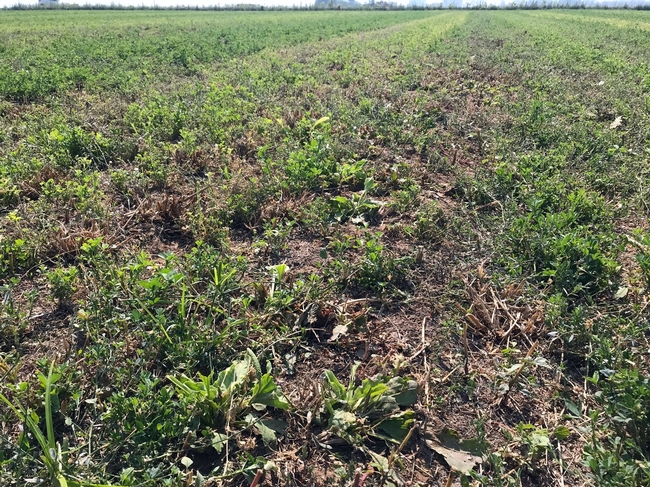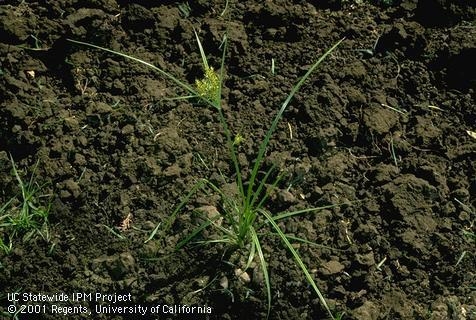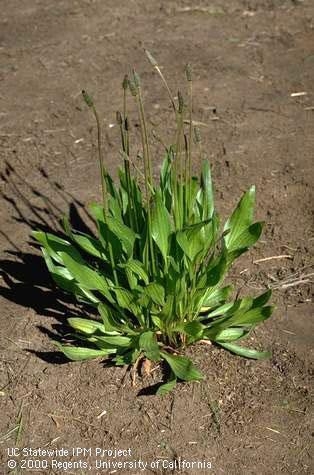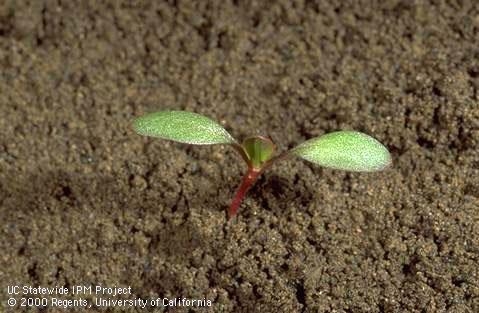- Author: Thomas Getts
- Author: Lynn M. Sosnoskie
- Author: Rachael Freeman Long
- Author: Mariano Galla
- View More...
The old saying, “Everything's fine until it's not,” comes to mind when dealing with some tough to control perennial weeds in alfalfa production during the summertime. Such was the case for an alfalfa field in the Sacramento Valley, where weed control seemed good up until mid-summer, and then it wasn't. Perennial weeds that started off small and overlooked, grew through the season, persisting through multiple cuttings, including curly dock, plantain, and nutsedge. For tough to control weeds in alfalfa fields, one needs to determine: 1) What types of perennial weeds are present, and 2) How many of them are there, to make a decision on how to manage them. These sorts of weed issues can creep up quickly in older alfalfa stands.
Photo One: Sacramento valley field full of perennial weeds
When growing hay, poisonous weeds should be high on any grower's radar. While plantain and nutsedge are benign, curly dock has potential to cause problems. Exposure to soluble oxalates that curly dock may contain are a low risk for renal disease for livestock because typically it is not that abundant in alfalfa hay fields. However, curly dock is also known to be able to accumulate toxic nitrate concentrations if grown under certain conditions, such as high levels of nitrogen fertilization (not typically applied in alfalfa), or frost. Regardless, high enough concentrations of any weeds in hay, poisonous or not, will lower the value and quality of the product produced, and should be addressed.
What can be done about perennial weeds right now for non-Roundup Ready (RR) alfalfa?
Grass weed control is relatively easy, with Poast (sethoxydim) or Select Max (clethodim) available for both annual and perennial grasses (e.g. barnyardgrass, foxtail, and Johnsongrass). Poast and Select Max are both systemic herbicides which move through the plant and are more effective when the weeds are actively growing. Middle of the season applications after cutting may be more effective following an irrigation, to ensure the weedy grasses are not drought stressed, so herbicide effectiveness is maximized.
Often mistaken as a grass, nutsedge can be difficult to control any time of the year. Applications of EPTC (Eptam) in irrigation water or use of a granular formulation can give suppression of nutsedge. The liquid formulation of EPTC requires uniform metering of the herbicide into water during irrigation, which may not be effective on heavy soils. Sandea (halosulfuron) can be used for post-emergence control of nutsedge in established alfalfa. However, Sandea can cause temporary stunting and yellowing of the crop when applied during the growing season in the Central Valley. The use of herbicides in rotational crops prior to alfalfa stand establishment is important in helping to reduce populations of nutsedge.
Photo Two: Yellow nutsedge can look a lot like a grass, but will not be controlled with grass herbicides
Perennial broadleaf weed control is challenging during the summer, particularly with well-established weed populations. Chateau (flumioxazin), or Shark (carfentrazone), might be of some help by providing a burndown of the aboveground foliage for perennial weed species. While this may sound desirable, most perennial weed species will regrow from the roots, just like the alfalfa, so control would be short lived and may only last for a single cutting. Both products have labels for weed control in established alfalfa between cuttings with language directing applications to be made as soon as possible after hay is removed from the field, and before there is 6 inches of regrowth on the alfalfa stand. It should be noted that both products will also burn back alfalfa in addition to the weeds.
Raptor (imazamox) can also provide control of some broadleaf and annual grass species. The label directs applications between cuttings to be made before there are 3-inches of alfalfa regrowth. Unlike Chateau and Shark, Raptor is a systemic product which will not burn back the weeds or alfalfa on contact, but can still cause a reduction in crop growth, while controlling small weeds. Unfortunately, out of the three problematic weeds in this field, only curly dock is listed on the Raptor label and only suppression, not control, can be expected from a successful application.
Butyrac 200 (2,4-DB) could be an option for control of either curly dock, or common plantain. According to the UC IPM herbicide sensitivity chart for alfalfa, Butyrac 200 is able to partially control established broadleaf plantain. Where the label indicates, applications to small curly dock plants less than 3-inches can also be expected to provide suppression. However, potential crop injury may also be a deterrent for use in established stands. Crop safety of alfalfa to Butyrac 200 is better for seedling alfalfa as compared to established plants, which are likely to display more leaf deformation and yellowing. If applications of Butyrac 200 are made, healthy, actively growing alfalfa will be more tolerant to the applications than stressed plants. As Butyrac 200 is a restricted material, it is important to follow the regulations and best management practices for use, in order to reduce the potential for off target movement.
Photo Three: Established buckhorn plantain
Should a treatment be made?
At this time of year, alfalfa foliage burn back from products like Shark or Chateau is temporary, lasting about a week; visual effects from dormant season applications with these herbicides may last a month or more. There may be a 7 to 10 day loss of growth when using these herbicides mid-season (right now). If using these contact herbicides between cuttings, either let the alfalfa grow longer before harvesting (our recommendation) or expect approximately a 10% yield loss for a scheduled 28-day interval cutting. Other post-emergence selective herbicides are either not registered for use during the growing season, or they have too long of a pre-harvest interval (PHI) to be utilized in most California systems.
Poisonous Weeds? Certainly, if there are poisonous weeds out there like groundsel, the decision to treat is made easy, but if they are standard run of the mill weeds, a decision needs to be made on what is tolerable to both the consumer, and the producer. Recently germinated summer annual weeds in large enough numbers can be prime examples of when mid-season applications between cuttings may be necessary and cost effective. Treating well-established populations of most perennial weeds between cuttings may be a waste of time, as perennial weeds will be suppressed, not controlled, making crop yield loss from herbicide injury much less acceptable.
Mid-season alfalfa herbicides treatments can be further confounded by the cutting cycles. Weeds are most susceptible to chemical treatments right after they have germinated when they are small and actively growing, which is why most alfalfa weed control measures take place in the late fall or early winter. Established annual and perennial weeds, which have been cut in an alfalfa field, can be less susceptible to herbicide control, as they become ‘hardened-off' from being cut and drought stressed during the harvesting process.
Dormant Periods. The dormant season is when most alfalfa weed control applications occur targeting winter annual weeds and the first flushes of summer annual weeds. The dormant season applications can also be effective at suppressing or controlling perennial weeds in the field. Applications of Gramoxone (paraquat) and Velpar (hexazinone) are standard dormant season treatments with a wide spectrum of weed control. Seedlings of most perennial species, including curly dock, will be controlled by Velpar applications. More established curly dock plants and other perennial species can be suppressed by the dormant season treatments but are typically not eliminated. Other perennial species such as yellow nutsedge which are not active at time of application can be missed by dormant season applications.
Photo Four: Curly dock seedling (Many perennial weeds are much more susceptible to dormant season herbicide treatments when they are seedlings)
The best time to control perennial weed populations in alfalfa is before the stand is established. Crop rotation allows the ability to target difficult to control species in crops that utilize more effective weed control practices, for example, broadleaf weed control in wheat. In fields with heavy perennial weed populations, RR alfalfa may be a good choice for producers not able to address the perennial weed problem before establishment. With conventional varieties, mid-season perennial weed control may require a trade-off between weed control and crop injury concerns. Growers need to determine 1) what types of perennial weeds are present and 2) how many of them are there? These factors will determine if a bit of injury to the alfalfa would be worth trying to clean up the field with an herbicide application.







